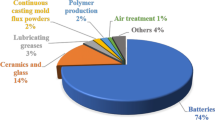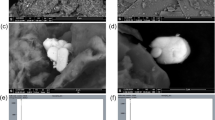Abstract
Experiments of boron incorporated into Mg(OH)2 from magnesium-free synthetic seawater were carried out at various pH values, in order to investigate the adsorption species and the variation of isotopic fractionation of boron on Mg(OH)2. The results showed that the incorporation of boron into Mg(OH)2 was very rapid and reached the equilibrium after 4 h. The [B]s and the partition coefficient K d between Mg(OH)2 and final solution decreased with the increasing pH. The maximum values of [B]s and K d were much higher than that of boron adsorbed on metal oxide or clay minerals, indicating that the incorporation capability of boron into Mg(OH)2 was very strong. When the adsorption reached the equilibrium, the δ 11Bfsw was lower than δ 11Bisw. The boron isotopic fractionation α s-fsw was between 1.0186 and 1.0220 with an average of 1.0203. All these indicated that 11B incorporated into Mg(OH)2 preferentially due to B(OH)3 incorporation into Mg(OH)2 preferentially. The deposition reaction of B(OH)3 with Mg(OH)2 was the direct reason for B(OH)3 incorporation into Mg(OH)2. During the boron incorporation into Mg(OH)2, the isotopic fractionation characteristic of boron was decided by the simultaneous existence of adsorption of boron on Mg(OH)2 and the deposition reaction of H3BO3 with Mg(OH)2. Different from the fact that only B(OH) −4 species incorporated into bio-carbonate, B(OH)3 and B(OH)4 incorporated into Mg(OH)2 simultaneously, and B(OH)3 incorporated into it preferentially. The lower pH is, the more incorporated fraction of B(OH)3 will be. Mg(OH)2 exists widely in madrepore, which influences the quantitative correspondence of the boron isotopic composition δ 11Bcarb of corals on the pH of the seawater badly, and brings serious uncertainty to the δ 11Bcarb as the indicator of the ancient seawater pH.
Similar content being viewed by others
References
Ishikawa T, Nakamura E. Boron isotope systematics of marine sediments. Earth Plan Sci Lett, 1993, 117: 567–580
Hemming N G, Hanson G N. Boron isotopic composition and concentration in modern marine carbonates. Geochim Cosmochim Acta, 1992, 56: 537–543
Vengosh A, Kolodny Y, Starinsky A, et al. Coprecipitation and isotopic fractionation of boron in modern biogenic carbonates. Geochim Cosmochim Acta, 1991, 55: 2901–2910
Spivack A J, You C F, Smith J. Foraminiferal boron isotopic ratios as a proxy for surface ocean pH over the past 21 Myr. Nature, 1993, 363: 149–151
Gaillardet J, Allègre C J. Boron isotopic compositions of corals: Seawater or diagenesis record? Earth Plan Sci Lett, 1995, 136: 665–676
Sanyal A, Hemming N G, Hanson G N, et al. Evidence for a high pH in the glacial ocean from boron isotopes in foraminifera. Nature, 1995, 373: 234–236
Sanyal A, Hemming N G, Broecker W S, et al. Changes in pH in the eastern equatorial Pacific across stage 5–6 boundary based on boron isotopes in foraminifer. Global Biogeochem Cycles, 1997, 11: 125–133
Palmer M R, Pearson P N, Cobb S J. Reconstructing past ocean pH-depth profiles. Science, 1998, 282: 1468–1471
Pearson P N, Palmer M R. Middle Eocene seawater pH and atmospheric carbon dioxide concentrations. Science, 1999, 284: 1824–1826
Pearson P N, Palmer M R. Atmospheric carbon dioxide concentrations over the past 60 million years. Nature, 2000, 406: 695–699
Lécuyer C, Grandjean P, Reynard B, et al. 11B/10B analysis of geological materials by ICP-MS Plasma 54: Application to the boron fractionation between brachiopod calcite and seawater. Chem Geol, 2002, 186: 45–55
Sanyal A, Nugent M, Reeder R J, et al. Seawater pH control on the boron isotopic composition of calcite: Evidence from inorganic calcite precipitation experiments. Geochim Cosmochim Acta, 2000, 64: 1551–1555
Hemming N G, Reeder R J, Hanson G N. Mineral-fluid partitioning and isotopic fractionation of boron in synthetic calcium carbonate. Geochim Cosmochim Acta, 1995, 59: 371–379
Sanyal A, Hemming N G, Broecker W S, et al. Oceanic pH control on the boron isotopic composition of foraminifera: Evidence from culture experiments. Paleoceanography, 1996, 11: 513–517
Palmer M R, Spivack A J, Edmond J M. Temperature and pH controls over isotopic fractionation during adsorption of boron on marine clay. Geochim Cosmochim Acta, 1987, 51: 2319–2323
Pagani M, Lamarchand D, Spivack A, et al. A critical evaluation of the boron isotope-pH proxy: The accuracy of ancient ocean pH estimates. Geochim Cosmochim Acta, 2005, 69: 953–961
Xiao Y K, Li S Z, Wei H Z, et al. An unusual isotopic fractionation of boron in synthetic calcium carbonate precipitated from seawater and saline water. Sci China Ser B-Chem, 2006, 49(5): 454–465
Lemarchand E, Schott J, Gaillardet J. How surface complexes impact boron isotope fractionation: Evidence from Fe and Me oxides sorption experiments. Earth Plan Sci Lett, 2007, 260: 277–296
Peak D, Luther III G W, Sparks D L. ATR-FTIR spectroscopic studies of boron acid adsorption on hydrous ferric oxide. Geochim Cosmochim Acta, 2003, 67: 2551–2560
McElligott S, Byrne R H. Interaction of B(OH) 03 and HCO −3 in seawater: formation of B(OH)2CO −3 . Aquat Geochem, 1998, 3: 345–356
Tossell J A. Boric acid adsorption on humic acid: Ab initio calculation of structures, stabilities, 11B NMR and 11B, 10B isotopic fractionations of surface complexes. Geochim Cosmochim Acta, 2006, 70: 5089–5103
Petric N, Martinac V, Labor M, et al. Isothermal and activated sintering of magnesium oxide from sea water. Mater Chem Phys, 1998, 53: 83–87
Polat H, Vengosh A, Pankratov I, et al. A new methodology for removal of boron from water by coal and fly ash. Desalination, 2004, 164: 173–188
Liu Y S, Li F Q, Wu Z M. Study on adsorption of boron on magnesium hydroxide in brine (in Chinese). J Salt Lake, 2004, 12(4): 45–48
Yuan J J, Cui R, Zhang Y. Study on the adsorption of magnesium hydroxide to boron in seawater and the removal of boron in brine (in Chinese). J Salt Chem Ind, 2006, 36(1): 1–6
Wang L M. Adsorption effect of magnesium hydroxide on boron in seawater (in Chinese). Sea-Lake Salt Chem Ind, 2003, 32(5): 5–7
Fallon S J, McCulloch M T, Woesik V R, et al. Corals at their latitudinal limits: laser ablation trace element systematics in Porites from Shirigai Bay, Japan. Earth Plan Sci Lett, 1999, 172: 221–238
Smith P L, Delong R C. Brucite in modern corals. Geol Soc Am Abst Prog, 1978, 10: 494
Nothdurft L D, Webb G E, Buster N A, et al. Brucite microbialites in living coral skeletons: Indicators of extreme microenvironments in shallow-marine settings. Geology, 2005, 33: 169–172
Wang Q Z, Xiao Y K, Wang Y H, et al. Boron separation by the two-step ion-exchange for the isotopic measurement of boron (in Chinese). Chin J Chem, 2002, 20: 45–50
Xiao Y K, Liao B Y, Liu W G, et al. Ion exchange extraction of boron from aqueous fluids by Amberlite IRA 743 resin. Chin J Chem, 2003, 21: 1073–1079
Xiao Y K, Beary E S, Fassett J D. An improved method for the high-precision isotopic measurement of boron by thermal ionization mass spectrometry. Int J Mass Spect Ion Proc, 1988, 85: 203–213
Catanzaro E J, Champion C E, Garner E L, et al. Boric Acid: Isotopic and Assay Standard Reference Materials. US Nat Bur Stand Spec Publ, 1970, 260(17): 70
Keren R, Mezuman U. Boron adsorption by clay minerals using a phenomenlogical equation. Clays Clay Miner, 1981, 29(3): 198–204
García-Soto M M F, Camacho E M. Boron removal by means of adsorption with magnesium oxide. Sep Purif Technol, 2006, 48: 36–44
Goldberg S, Glaubig R A. Boron adsorption on aluminium and iron oxide minerals. Soil Sci Soc Am J, 1985, 49: 1374–1379
Goldberg S, Glaubig R A. Boron adsorption and silicon release by the clay minerals kaolinite, montmorillonite and illite. Soil Sci Soc Am J, 1986, 50: 1442–1448
Keren R, Gast R G. pH-dependent boron adsorption by montmorillonite hydroxy-aluminium complexes. Soil Sci Soc Am J, 1983, 47: 1116–1121
Lemarchand E, Schott J, Gaillardet J. Boron isotope fractionation related to boron sorption on humic acid and the structure of surface complexes formed. Geochim Cosmochim Acta, 2005, 69: 3519–3533
Rodionov A I, Voitova O M, Romanov N Y. The current state of the problem of the elimination of boron from waste waters. Russ Chem Rev, 1991, 60(11): 1271–1279
Vengosh A, Kolodny Y, Starinsky A, et al. Coprecipitation and isotopic fractionation of boron in modern biogenic carbonates. Geochim Cosmochim Acta, 1991, 55: 2901–2910
Author information
Authors and Affiliations
Corresponding authors
Additional information
Supported by the National Natural Science Foundation of China (Grant Nos. 40573013 and 40776071) and International Partnership Project of Chinese Academy of Sciences
About this article
Cite this article
Xiao, J., Xiao, Y., Liu, C. et al. Boron isotopic fractionation during incorporation of boron into Mg(OH)2 . Chin. Sci. Bull. 54, 3090–3100 (2009). https://doi.org/10.1007/s11434-009-0138-y
Received:
Accepted:
Published:
Issue Date:
DOI: https://doi.org/10.1007/s11434-009-0138-y




